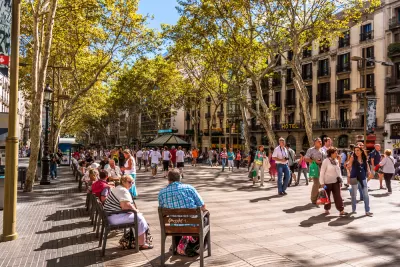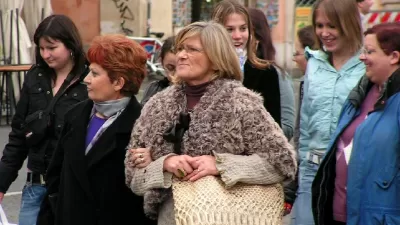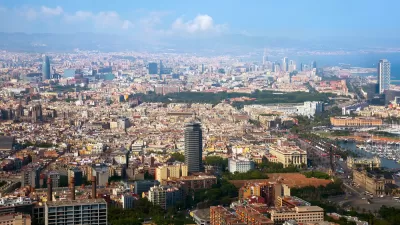Seeking relief from noise, pollution, and incessant traffic, the city of Barcelona has a bold plan to repurpose street space. "Superblocks" will route cars around the perimeter, leaving interior streets open for walkers and bikes.

Like many American cities, Barcelona devotes most of its road space to cars: "Private vehicles account for just 20% of total movements in the city today and yet they occupy 60% of roads." In pursuit of a 21% reduction in traffic, Barcelona's new mobility plan places heavy emphasis on the concept of superilles, or "superblocks." Marta Bausells discusses the ambitious plan in detail.
"In Eixample, a superblock will consist of nine existing blocks of the grid. Car, scooter, lorry and bus traffic will then be restricted to just the roads in the superblock perimeters, and they will only be allowed in the streets in between if they are residents or providing local businesses, and at a greatly reduced speed of 10km/h (typically the speed limit across the city is 50km/h, and 30km/h in specific areas)."
The city will roll out the superblock concept in series of gradual interventions, changing road signs and bus routes while leaving much of the streetscape intact. The superblocks idea has been around since 1987, and the first tests began in Barcelona in 2003. Currently, the idea is already being tested in nine districts via a trial-and-error process that has been called tactical urbanism.
The city hopes to achieve its 21% traffic reduction in two years, along with a corresponding shift to bikes, buses, and pedestrian trips. To get there, 300 km of new bike lanes are in the works.
FULL STORY: Superblocks to the rescue: Barcelona’s plan to give streets back to residents

Study: Maui’s Plan to Convert Vacation Rentals to Long-Term Housing Could Cause Nearly $1 Billion Economic Loss
The plan would reduce visitor accommodation by 25% resulting in 1,900 jobs lost.

Alabama: Trump Terminates Settlements for Black Communities Harmed By Raw Sewage
Trump deemed the landmark civil rights agreement “illegal DEI and environmental justice policy.”

Why Should We Subsidize Public Transportation?
Many public transit agencies face financial stress due to rising costs, declining fare revenue, and declining subsidies. Transit advocates must provide a strong business case for increasing public transit funding.

Paris Bike Boom Leads to Steep Drop in Air Pollution
The French city’s air quality has improved dramatically in the past 20 years, coinciding with a growth in cycling.

Why Housing Costs More to Build in California Than in Texas
Hard costs like labor and materials combined with ‘soft’ costs such as permitting make building in the San Francisco Bay Area almost three times as costly as in Texas cities.

San Diego County Sees a Rise in Urban Coyotes
San Diego County experiences a rise in urban coyotes, as sightings become prevalent throughout its urban neighbourhoods and surrounding areas.
Urban Design for Planners 1: Software Tools
This six-course series explores essential urban design concepts using open source software and equips planners with the tools they need to participate fully in the urban design process.
Planning for Universal Design
Learn the tools for implementing Universal Design in planning regulations.
Smith Gee Studio
Alamo Area Metropolitan Planning Organization
City of Santa Clarita
Institute for Housing and Urban Development Studies (IHS)
City of Grandview
Harvard GSD Executive Education
Toledo-Lucas County Plan Commissions
Salt Lake City
NYU Wagner Graduate School of Public Service





























